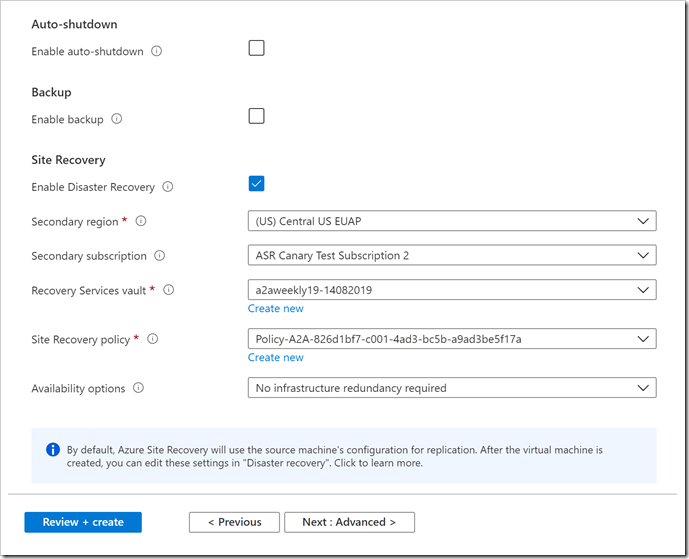May 19, 2022
Microsoft has lately announced a new capability in Azure Site Recovery to further improve the Business Continuity and Disaster Recovery posture of Azure VMs – in-line enablement of ASR at the time of VM creation.

This capability helps all Azure infrastructure customers avoid the hassle of separately configuring DR across regions (or zones) after the creation of VMs.
Microsoft recognizes that as the customers move and more business-critical applications to Azure, their resilience is of prime importance.
ASR is a key pillar of Microsoft’s resiliency offering, which allows customers to protect their Azure VMs against regional outages.
Previously, there was no seamless way to enable ASR during the creation of a VM. End customers had to follow through and execute a different workflow to protect the VM from regional (or zonal) outages after the VM was up and running.
With Microsoft latest release, now all end customers will be able to enable ASR while creating a VM. ASR will be one of the VM Management options alongside the ones currently available for configuration – Monitoring, Identity, and Backup, among others.
To get started, a customer can simply head over to the Azure portal. Go to ‘Virtual machines’ and click on ‘+ Add’. Go to the Management tab and select ‘Enable Disaster Recovery’ under ‘Site Recovery’. Make the relevant selections and proceed to create Azure VM. Once the VM is created, replication will be automatically enabled within a few minutes.
It shall be noted that so far, this offering is currently limited to Windows VMs and CentOS, Oracle Linux, and Red Hat Linux VMs. Microsoft also do not support zone to zone (in region) disaster recovery through the Create VM workflow currently.
Sep 8, 2021
Microsoft is announcing changes to the commercial pricing for Microsoft 365—the first substantive pricing update since they’ve launched Office 365 a decade ago.
This updated pricing reflects the increased value Microsoft has delivered to its customers over the past 10 years.
Take a look at some of the innovations they’ve delivered over the past decade in three key areas—communications and collaboration, security and compliance, and AI and automation—as well as the addition of audio conferencing capabilities that they’re announcing today.
A decade of continuous innovation
Since introducing Microsoft 365 they have added 24 apps1 to the suites—Microsoft Teams, Power Apps, Power BI, Power Automate, Stream, Planner, Visio, OneDrive, Yammer, and Whiteboard—and have released over 1,400 new features and capabilities in three key areas.
→ Communication and collaboration.
In 2020 Microsoft released over 300 new capabilities including Together mode, background effects, large gallery view, raise a hand, live reactions, breakout rooms, live captions with speaker attribution, and Fluid components, just to name a few.
- They introduced a new category of collaborative applications in Teams, empowering people and organizations for hybrid work through deep integrations with Power Platform, Whiteboard, Lists, Planner, Shifts, Forms, and SharePoint. Companies like Adobe, Atlassian, Salesforce, SAP, ServiceNow, and Workday have built apps that deeply integrate with Teams, bringing business processes and functions directly into the flow of work.
- They continue to innovate on both real-time and asynchronous collaboration.
- They introduced real-time collaboration in Word, Excel, and PowerPoint desktop apps while a growing set of capabilities like @mentions, assign tasks, modern comments, and auto-save have streamlined the collaboration experience.
- They’ve added and expanded OneDrive cloud storage and the Exchange Online mailboxes.
→ Security and compliance.
- The cybersecurity landscape is more complex than ever. With the accelerating volume, sophistication, and scale of cyberattacks, security and compliance are a priority for every organization. Since they first introduced Microsoft 365, they have added new attack surface reduction capabilities to help organizations defend against ransomware and other threats.
- They have added capabilities like data loss prevention (DLP) for email and documents, sensitivity labels, and message encryption to help keep important data within the organization.
- They have added powerful compliance capabilities that help organizations reduce risk and respond to increasing regulatory requirements such as Content Search, eDiscovery, and core Litigation Hold. Built-in mobile device management (MDM) and other management tools like Microsoft Endpoint Manager help admins support remote and hybrid workforces.
→ AI and automation.
- Over the past decade, they have infused AI capabilities across our productivity and collaboration applications to help everyone achieve more.
- Across Microsoft 365, they have introduced AI-powered innovations to help users be better writers, designers, and presenters.
- Cloud-powered AI now automatically creates maps, charts, and tables in Excel, and sorts email and removes clutter in Outlook. And AI-powered real-time translation, captions, and transcription make collaboration and communication more accessible and engaging for everyone.
Extending audio conferencing capabilities
- Microsoft is announcing that they will add unlimited dial-in capabilities for Microsoft Teams meetings across our enterprise, business, frontline, and government suites over the next few months. Even as cloud connectivity increases, they know that people join Teams meetings while they are on the go or struggling with a bad internet connection.
- Currently included with Microsoft 365 E5 and Office 365 E5, they have come to see dial-in as an important part of the complete Teams experience.
- Available with subscriptions in over 70 countries and with interactive support in 44 languages and dialects, unlimited dial-in provides peace of mind that users will be able to join their Microsoft Teams meeting from virtually any device regardless of location.
New pricing
- The pricing changes Microsoft is announcing today will go into effect in six months.
- On March 1, 2022, they will update our list pricing for the following commercial products: Microsoft 365 Business Basic (from $5 to $6 per user), Microsoft 365 Business Premium (from $20 to $22), Office 365 E1 (from $8 to $10), Office 365 E3 (from $20 to $23), Office 365 E5 (from $35 to $38), and Microsoft 365 E3 (from $32 to $36).
- These increases will apply globally with local market adjustments for certain regions.
- There are no changes to pricing for education and consumer products at this time.
- As leaders around the world look to empower their people for a more flexible, hybrid world of work, it’s clear that every organization will need a new operating model across people, places, and processes. Microsoft is committed to building on the value they’ve delivered over the past decade to continuously provide innovation that helps our customers succeed and thrive today and well into the future.
Click to learn more
Contact us to learn more [email protected]
Jun 10, 2021
As a cloud-native SIEM, Azure Sentinel offers significant cost benefits. They have seen Azure Sentinel and the promise of cloud-native SIEM result in cost savings, both direct and indirect, for many of their customers. The 2020 commissioned Forrester Consulting Total Economic Impact™ of Microsoft Azure Sentinel study, for example, found that Azure Sentinel delivered a 48% reduction in costs compared to legacy SIEMs, saving on expenses like licensing, storage, and infrastructure costs.
Microsoft are pleased to announce changes to the pricing of Azure Sentinel and Azure Monitor Log Analytics that will offer you additional cost savings. These changes take effect on June 2.
The changes include:
New capacity reservation naming
Capacity reservations are now called commitment tiers. You will see this change reflected in your user interface, in documentation, as well as on Azure Sentinel and Azure Monitor pricing pages and in the pricing calculator.
New, higher commitment tiers
They are introducing new commitment tiers for both Azure Sentinel and Azure Monitor Log Analytics for higher data ingestion: 1 TB/Day, 2 TB/Day, and 5 TB/Day.
Changes to how we bill for data ingestion over your commitment tiers
They are also changing the way we bill for overage. Data ingested beyond your selected commitment tier will now be billed using the effective commitment tier rate, instead of the Pay-as-you-go rate, resulting in a lower bill.
For example, for Azure Sentinel in the East US region, if you are on a 500 GB/day commitment tier, you will now be billed for overage at $0.80/GB (i.e. the effective rate for that tier) instead of the $2/GB pay-as-you-go rate.
Simplification of commitment tiers
They are simplifying commitment tiers to make them easier to manage. You can now select from eight distinct commitment tiers, per your needs, and no longer need to manage tiers due to minor changes in data ingestion patterns.
As part of this change, any workspaces with commitment tiers greater than 500 GB/day will be reset to the lowest available commitment tier – 500 GB/day, 1 TB/day, 2 TB/day, or 5 TB/day. This change should lower your costs due to the lowered cost of overage.
For example, if you were previously on a 600 GB/day commitment tier, your commitment tier would now be to 500 GB/day. Due to the change in overage billing, on days when you ingest more than 600GB, you would get billed at the 500GB effective tier rate, and on days you ingest less than 600GB, you save money because you are at a lower commitment tier – saving you costs overall.
Learn More
We’re excited to help you save costs with these changes, and look forward to continuing to innovate with Azure Sentinel and Azure Monitor Log Analytics.
May 19, 2021
Microsoft has introduced the first per-user Power BI Premium offers. Power BI Premium is currently sold only in a capacity construct.
Power BI Premium Per User provides access to enterprise business intelligence (BI) and analytics capabilities. Its flexible individual seat licensing caters to small and medium-sized businesses.
Power BI Premium Per User allows organizations to license Premium features on a per-user basis.
Premium Per User (PPU) includes all Power BI Pro license capabilities, and also adds features such as paginated reports, AI, and other capabilities that are only available to Premium subscribers.
With a PPU license, you do not need a separate Power BI Pro license, as all Pro license capabilities are included in PPU.
You can get a trial version of Premium Per User (PPU) through Microsoft 365, as long as your organization has not restricted PPU licenses. Trials are enabled through the portal, similar to how Power BI Pro licenses are initiated.
The following table describes the Premium Per User (PPU) features against a Premium capacity:

Mar 23, 2021
“BPS” in collaboration with “Al-Iktissad Wal-Aamal organized a webinar entitled “Cloud Talks 2021”, to discuss the services and applications offered by cloud computing providers in order to empower digital business transformation while preserving security, privacy and compliance with laws and regulations. Over 120 persons representing senior executives from 12 different countries participated in the webinar, which hosted experts from leading companies and technology providers from the MENA region.
The Digital Transformation Journey
Mahmoud Moussa -Senior Cloud Solution Architect for Data & AI, Microsoft – confirmed, during his participation in the webinar, that the “Azure IoT Edge” technology provided Microsoft allows the delivery of sensors from all the company’s departments and its use in order to connect to another backend related to the Internet of Things where the data is sent after being initially processed. He explained that cloud services seek to enable digital technology through several domains, most notably: The Internet of Things and Edge technology, advanced analytics, artificial and cognitive intelligence, graphic technique, Blockchain technology, digital workplace and 3D imaging.
For his part, the Sales Manager at Citrix, Abbas Ali-Ahmad pointed out that success will go to the organizations and companies that will be able to provide a stable and safe work experience. He emphasized on the importance of knowing how to support any type of users wanting to access information; whether they were employees, contractors or business partners, and the possibility to work from any place, using any type of device or computing system.
As for Eiad Al-Aqqad -the Principal Solution Architect at “VMware Cloud Providers Program”- he discussed the vision of “VMware Cloud” in the world of cloud computing, he explained that their vision allows users and cloud service providers to activate any application on any device of any kind.
Cyber Security and Cloud Computing
In a panel discussion, moderated by Parthasarathy Pillairkulam – EVP-Chief Information Security Officer at First Abu Dhabi Bank- General Manager of Capital outsourcing, Chadi Ghazal, indicated that his company was the first to own a cloud platform in the MENA region since 2000. He explained that cloud computing is a virtual process for hardware, software, networks, storage spaces and services used by developers to implement complex operations. Adding that when using cloud computing, companies are not compelled to purchase any new devices or services, however they need to upgrade their virtual storage for a certain fee.
As for Alain Sawaya -General Manager of the Jordanian “Zain Datapark”- he explained that his company is an entity that was founded to enable “Zain Group” to provide cyber security and cloud computing services everywhere. He added that every country aspires to have its own cloud located within its territory for multiple reasons: legitimacy, data sovereignty and to secure data especially for governments. Furthermore, he announced the transfer of severl financial and banking applications to private cloud servers.
On his behalf, Mohamed Ayad, Vice President and Business Development Manager of “Libyan Spider” considered that country cloud and public cloud approaches are closer to each other today more than ever, indicating that “Microsoft” is expanding this service very quickly.
Ayad pointed out that there have been concerns about data security and privacy from the very first day of the cloud model’s birth, which has greatly affected companies’ work. He continued adding that many companies have switched to using public cloud more than before due to the flexibility with which entrusted public cloud providers work.
On the other hand, General Manager of “Gulf Infotech” in Oman, Yahya Zakir Sait, said that the largest companies providing cloud services have neglected the Middle East region in 2009 due to the low adoption of cloud solutions, pointing out that the high demand for adopting these solutions has created a quantum leap for the region in general.
“BPS” and Digital Transformation
BPS provides vendors with multiple licensing programs, services and technical supports to partners in order to develop their businesses, in addition to “SAM” consultations. The company focuses on supporting MSP focused channel, telecom companies, internet service providers, database centers, service providers, integrated systems, managed services, software companies and IT distributors who are heading towards digital and cloud transformation.
The company always strives to add more services to its own affiliated program. It started its operations as a cloud distributor in 2005 and has earned years of local experience in the cloud channel business, to become today a pioneer in this field in the MENA region.
May 14, 2020

Microsoft are announcing a product name change only for some of Microsoft365 products. There are no pricing or feature changes at this time!
The new product names are already into effect since the 21st of April , 2020. The below table shows the Old & New naming for each modified product:
| Old Name |
New Name |
| Office 365 Business Essentials |
Microsoft 365 Business Basic |
| Office 365 Business Premium |
Microsoft 365 Business Standard |
| Microsoft 365 Business |
Microsoft 365 Business Premium |
| Office 365 Business |
Microsoft 365 Apps. For Business |
| Office 365 ProPlus |
Microsoft 365 Apps. For Enterprise |
However, no changes were done for the below products:
- Office 365 for Enterprise (E1, E3, E5)
- Office 365 for Firstline workers (F1)
- Office 365 for Education (A1, A3, A5)
- Office 365 for Government (G1, G3, G5)
Linked below are two comparison sheets for both Microsoft 365 and Office 365 showing the availability features/products for each plan for both Commercial & Educational plan











